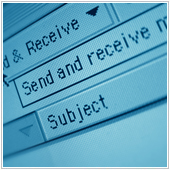
Here are five tips on how you can write better subject lines for your emails.
1. Standardize where possible
Many of us in the business world send out emails on a daily or weekly basis that ask the same question or serve the same purpose – think of rate sheets, product updates, or daily work assignments. In order to be more effective and save yourself a little time, why not standardize the subject line for similar emails? For example, if you send out a weekly update with important information to suppliers, use the same subject line such as – ‘Weekly Supplier Update 12/1 to 12/7’. Using a standardized format should reduce confusion over content, and lets recipients know clearly exactly what the email is about. This in turn means fewer reply emails and questions, and therefore means more time for you to focus on other tasks.
2. It’s OK to use some abbreviations
Despite what your teachers might have stressed about grammar during school lessons, abbreviations and acronyms are actually fine to use in email subject lines. The key here is to only use those that are commonly known. For example, FYI (for your information) and RE (regarding) are perfectly acceptable for business use.
If you are going to use specific acronyms or abbreviations that people may not know, you need to reference the meaning in some way. An easy way to do this is to use them in the body of the email first, and explain what they mean the first time you use them. Take, for example, “WRT” (with regard to), which is increasingly used, but not necessarily known universally .
3. KISS your subject lines
We don’t mean actually bend forward and smooch your monitor – that would be a little weird. What we mean is ‘Keep It Simple Stupid’. When writing subject lines, try to keep them as simple as possible. Don’t use confusing words, and don’t write long sentences. That being said, don’t go too far the other way. Sometimes one or two word subject lines may not be enough to get the point across and may actually create questions or confusion. Take a look at the subject you write and ask yourself if it is as simple as possible, yet clear enough to avoid any misunderstanding.
4. Be as specific as possible
While keeping it simple is important, you also need to keep subject lines specific. A great subject line will tell the user exactly what the email is about. For example, if you are inviting customers to a webinar on your newest service, a subject line that says something along the lines of “Webinar in November” is ambiguous and likely to get ignored. Instead write something like “New Service Webinar Invitation Dec 16,” which is much more specific and more likely to spark interest in users and get them to open the email and read on.
5. Write actionable subject lines
Sometimes the reason we send an email is that we want the recipient to do something; take some action or provide some information. We want them to act. Your recipient is probably busy, and won’t want to spend time trying to decipher an overly complex message. In these cases, simply including your intention and requested outcome in the subject line can be worthwhile.
For example, if you need a colleague to edit the monthly sales report, using a subject line like “Monthly sales report” may cause the employee to ignore the email or put it to the side for later, largely because they may think it’s a report, or not something on which they need to act. A subject line like “Edit Monthly Sales Report” immediately informs the recipient that you are requesting an action. It also saves you time having to go into lots of information in the body of the email.

